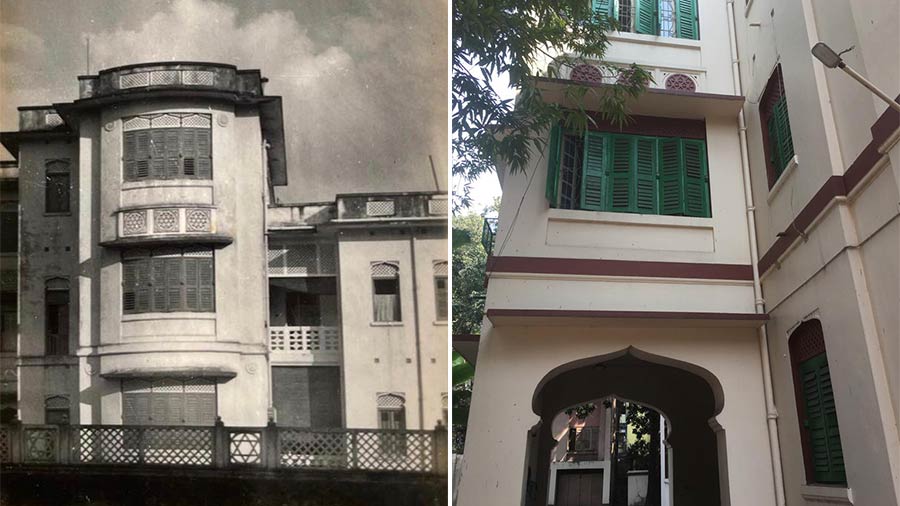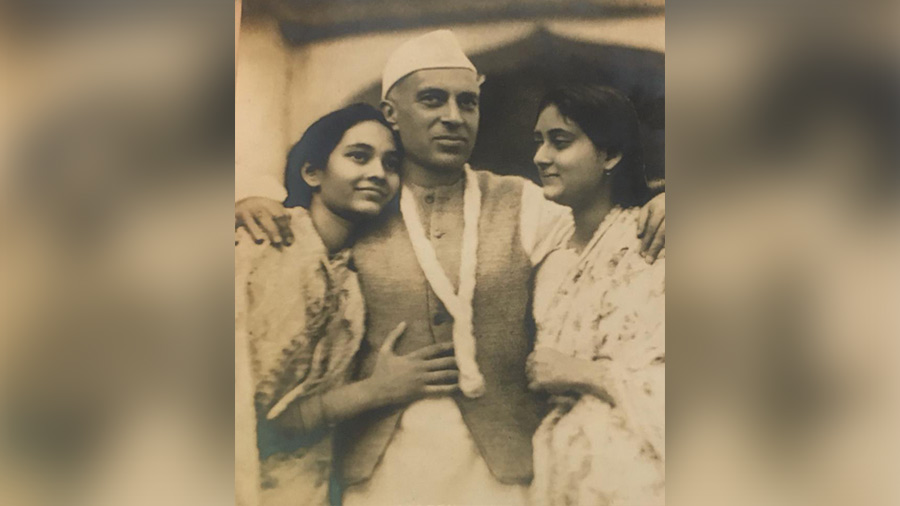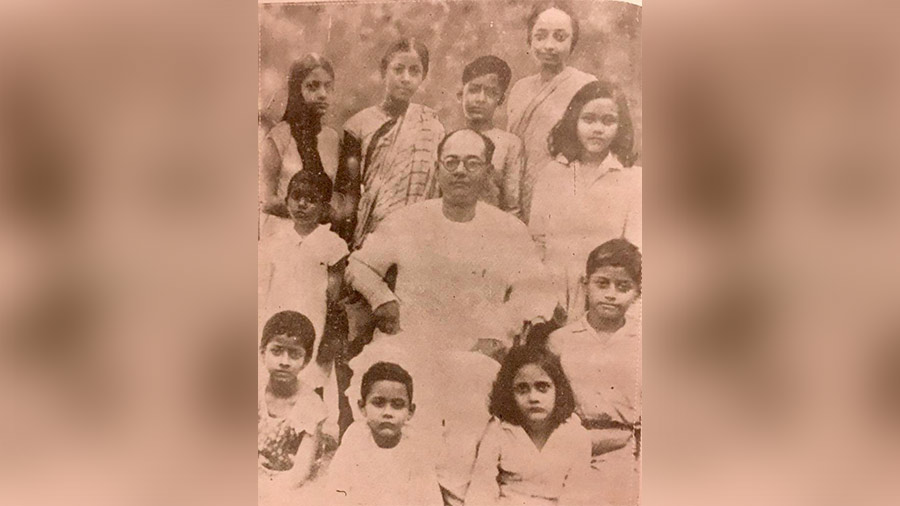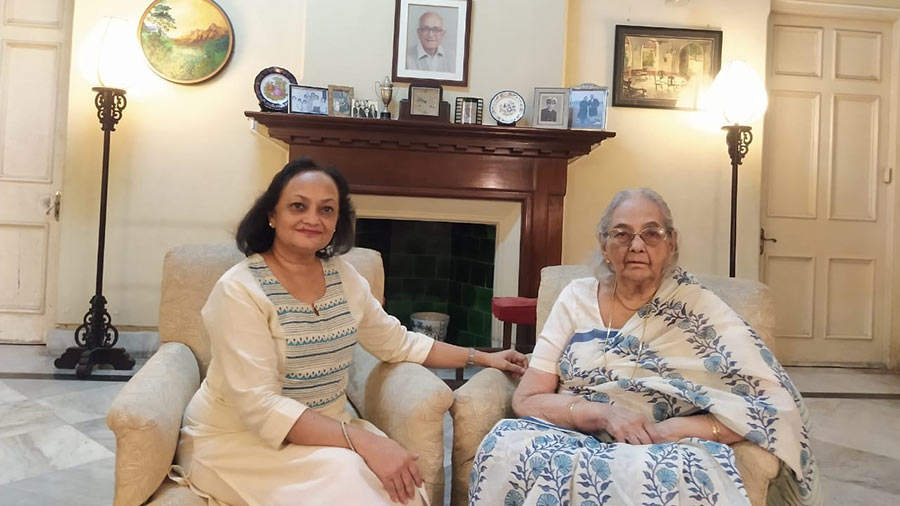Roma Ray was born on February 9, 1929. Her father was the illustrious barrister and freedom fighter, Sarat Chandra Bose. Her uncle, Subhas Chandra Bose needs no introduction, but to his niece, he was “Rangakakababu”.
At the age of 93, Roma Ray recounts memories from her childhood and early adulthood, growing up in the shadows of the great personalities of India’s socio-political history. My Kolkata sits in on a conversation led by her daughter Piali Ray, who is a teacher and an actor.
Roma Ray: Although the Bose family lived on Elgin Road, in the house we now know as Netaji Bhavan, my father built a house at Woodburn Park, where they shifted to in 1928, just before I was born. His brother, Subhas, also spent a lot of time at Woodburn Park for the space, privacy and support he received from my father. I was the first to be born in that house. I was among the youngest of eight siblings and very close to my younger brother and sister.

Roma Ray (left) with her father Sarat Chandra Bose and her siblings Chitra and Subrata
Piali Ray: My mother is now the eldest surviving member of both the Bose and the Ray families. Her father, Sarat Chandra, was a leading barrister of the Calcutta High Court, and much of what he earned was spent on the freedom movement and towards the politics of Subhas. He had so much affection for his younger brother, that it was apparent to all. He was once asked by an outsider, “Who matters more to you, your eight children or Subhas?” And he said, “If I were to put them on either side of the scale, I think the scales would tip heavily in favour of Subhas.” The Woodburn Park house is now government property. The Institute of Asian Studies was once running there.
Roma: My father had a towering personality but (Baba) was also a very loving, affectionate parent. We were all very close to him. And my mother was a very strict disciplinarian and never over-indulged her children. She was petite, very fair, with short curly hair and managed the household with great expertise.

1 Woodburn Park in the 1930s and (right) as it looks today
Piali: When my mother was three, Sarat Chandra Bose was imprisoned in Seoni jail in 1932, just outside Jabalpur, because of his involvement in the freedom struggle. Her mother, Bivabati, took her along to Seoni to meet her father where young Roma used to play with the other prisoners. This made her mother worried. Her father assured her, “They are just like me or any of us, so don’t be nervous, she will be absolutely safe with them.” These are all the stories I grew up with.
One of the things that had a great impact on me as I grew up was the simplicity with which they were brought up. Bivabati brought up the children strictly and on as much as they required and no more. Once a year, a man would come to supply saris and dhotis. Each person got a couple for the whole year. My mother and her sister shared their saris. They were given special saris to wear at weddings, so for one wedding they would wear their saris, at the next wedding, they would swap…. I think this helped all Sarat Chandra Bose’s children go through the ups and downs of life with a smile. Even when she brought her report card to her father every month, the fact that she stood first was never a big deal. He would be very happy, pat her on the back, encourage her, and that was it.

Sisters and best of friends Roma and Chitra were always similarly dressed
I was told at home not to display any excitement as the niece of the leader
Roma: Yes, I was a good student. I enjoyed history and I got a ‘letter’ in Geography. I was also enrolled in South Club to play tennis but I couldn’t really hit the ball well. I was better in the classroom than on the playground! There was once a large procession with Netaji, which passed by the school. It was in 1938, after he was elected president at the Haripura Congress Session. The girls rushed to the window for a look but I didn’t join them because I was told at home not to display any excitement as the niece of the leader. The teacher brought the girls back to order because school policy was not to encourage freedom fighters.
Piali: Even at home, it was made clear to the children that they had no part in all the comings and goings of the country’s leaders. Their studies were not to be disrupted even though Subhas was holding meetings with freedom fighters and people like Mahatma Gandhi, Jawaharlal Nehru, Indira Gandhi, and even Tagore came visiting. In fact, during one of Gandhi’s visits to 1 Woodburn Park, Tagore came to call on the Mahatma. Quite advanced in age, and not in good health, the poet had to be carried on a chair to a ground-floor room on the northern side. Many people had congregated to witness the meeting of Gurudev and the Mahatma. My mother’s sister Gita stepped forward to ask Gurdev for an autograph. She was then egged on by others to request the poet to add a few lines to his signature, which only read – ‘Aashirvaad, Rabindranath Thakur’. Gita mustered courage and returned to the poet with this request. Gurudev looked at her and said “Aamar baba ekta naam diyechhilen/ lokey taate kichhu daam diyechhe/ tumi taar oporeo phau chau?” (I have written the name given to me by my father and people have given a lot of value to that name, but you’re not happy with that?) Suitably chastised in verse, Gita decided to remain satisfied with his signature!

A cutting of the ‘Illustrated Weekly’
Get one of your daughters to marry a Harijan and I will attend the wedding: Gandhiji told my father
Roma: Gita’s autograph book had a formidable collection, which is now with the National Library. Our father invited Gandhiji to Gita’s wedding in December 1945. Gandhiji was in Calcutta at that time to attend the AICC (All India Congress Committee) meeting but declined the invitation because, on principle, he attended weddings of the ‘Harijan’ only. However, he visited our home the next morning to bless the newlyweds, and told my father, “Get one of your younger daughters to marry a Harijan and I will attend the wedding.” To which my sister and I started a tussle between ourselves, telling the other to marry a ‘Harijan’ so that Gandhiji would attend the wedding!
Piali: Special arrangements had to be made when Gandhiji came as a houseguest to 1 Woodburn Park. A room on the second floor was prepared for him. There was an adjacent terrace where he used to take walks twice a day. He used to suffer from hypertension and used some natural cures for this condition. He would sit on the terrace in a tub of water. The water would be heated in the sun and he would hold a moistened Ganga clay cake on his head. People who accompanied him included his secretary Mahadev Desai, Pyarelal (Nayyar) his attendant, and Sushila Behn who was Pyarelal’s sister. In the evenings, he would hold prayer meetings on the terrace. Very often, many famous artistes would perform for the Mahatma, such as S.D. Burman, Dilip Kumar Roy, and Gurusaday Dutt who once came with the Bratachari Sangha to perform in front of the Mahatma. Gandhiji had a diet of fruit and vegetables with homemade chapatis. A goat would be tethered on the premises and milked every day as he only drank goat milk.

Roma (left) with Jawaharlal Nehru and sister Gita at 1 Woodburn Park
Both Nehru and Indira would dress for dinner; Nehru would say, ‘Sarat’s meals never end’
Roma: I remember that both Nehru and Indira (Gandhi) ate very frugally. Indira was beautiful and slender, and she and her father would dress for dinner. Nehru would say, “Sarat’s meals never end.” He really liked the service of the retainers and once offered a job to Hussain, my father’s bearer. Hussain turned him down saying, “Ek Saab ka namak khaya”, which showed how loyal they were to him. Even our Mastermoshai — Phanindranath Dasgupta — offered to continue his tuitions without accepting any fees after my father was imprisoned in 1941. My father’s legal practice stopped for four years when he was imprisoned for being instrumental in Netaji’s escape.
Piali: They needed someone to drive Subhas out of the Elgin Road house on the night of his ‘escape’. Needless to say, the house was under watch as Subhas Bose was confined there under ‘house arrest’. Sisir was a medical student at the time and he had a car. For many days, every evening, sometimes late at night, he would take the car, go to Elgin Road, park the car there, spend some time, and then drive back. In the beginning, he used to be checked until they saw he was doing this every day. On the night of January 16, 1941, Netaji came down by the rear staircase, and crept into the back seat. He crouched on the floor and held the door close so that the police would hear only one door closing. He sat up only after they had driven for a long way!
The plan was to drive through the night and arrive at Barari (now in Bihar) in the early hours of the morning. My mother’s eldest brother Asoke Nath Bose was working in Barari, where he lived in a bungalow with his wife Mira. Subhas got out of the car and walked in through the gate disguised as an insurance agent, while Sisir entered with the car. Mira was not told who Subhas really was in case the servants came to know. He spent the day there and at night they all drove out to Gomoh station (now in Jharkhand). Asoke didn’t want to leave his wife alone in the bungalow, so she went too. When the insurance agent’s identity was revealed in the car, she was shocked that she hadn’t recognised him at all! At Gomoh, Subhas told Mira, “Bouma, forget everything you’ve seen today.” My mother was 12 then, and had no clue any of this was happening.

Roma (standing to the right, in a collared dress) with siblings, cousins and Rangakakababu Subhas Chandra Bose
Even if we were frightened, we couldn’t express it, we always had to be strong
Roma: The police never questioned Asoke and Mira because they thought Rangakakababu was driven directly to Gomoh. My brother Sisir and our cousins Dwijen Bose and Aurobindo Bose were also imprisoned and tortured in Lahore. My father was put into solitary confinement at Fairlight bungalow in Coonoor, where they kept a watch on him round-the-clock, with all doors and windows kept open and floodlights focused on all corners of the house. The police commissioner himself came to arrest my father at Woodburn Park but he refused to be taken away immediately because my sister Mira was due to have a baby soon. Eventually, he went to prison on December 9 and the child was born on December 11, in Woodburn Park. Sisir, who was a medical student, was picked up on the road. We didn’t even know then how much he had been involved and we were worried that his medical studies would be hampered. But then, even if we were frightened when all of this was happening, we couldn’t express it, we always had to be strong.

Roma (sitting) with mother Bivabati, brother Sisir and sister Chitra in Paris 1948
Piali: While Sarat Bose was in Coonoor, there was an incident which left a mark on my mother. She has spoken to us about it many times. The family had gone to visit him in Coonoor, and when they reached the bungalow, he kept asking my mother to go wash up as tea would be served soon. She replied that her hands were clean and she didn’t need to wash them. At this point, her father reprimanded her for being disobedient. So she made her way to the washroom wondering why her father had spoken to her so sharply.
I lifted the soap dish to find a neatly folded note in it! I slipped it into my pocket
Roma: I lifted the soap dish to find a neatly folded note in it. There was no soap! I slipped it into my pocket. When I came out, my father was looking at me questioningly, and I indicated that I had it. I later handed the note over to my brother, Asoke. It contained instructions about the freedom movement. My father felt that Independence was an eventuality which could not be avoided… it was always going to happen. But Partition spoilt the joy of independence for him.
Read more about Roma Ray here.

Roma and Chitra riding in procession on Azad Hind Day — October 21, 1947. Chitra passed away in January 2021 at age 90


